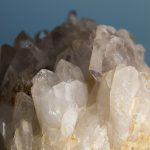Sapphirine is a rare mineral, a silicate of magnesium and aluminium. Named for its sapphire-like colour, sapphirine is primarily of interest to researchers and collectors: well-formed crystals are treasured and occasionally cut into gemstones. Sapphirine has also been synthesized for experimental purposes via a hydrothermal process.
Typical colours range from light to dark sapphire blue, bluish to brownish green, green, and bluish or greenish gray to black; less common colours include yellow, pale red, and pink to purplish pink. Sapphirine is relatively hard (7.5 on Mohs scale), usually transparent to translucent, with a vitreous lustre.
Source: en.wikipedia.org/wiki/Sapphirine




























Leave a Reply
You must be logged in to post a comment.